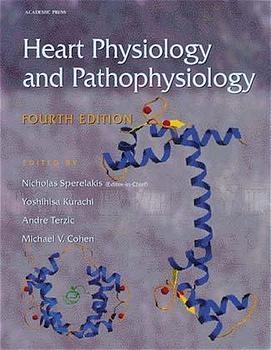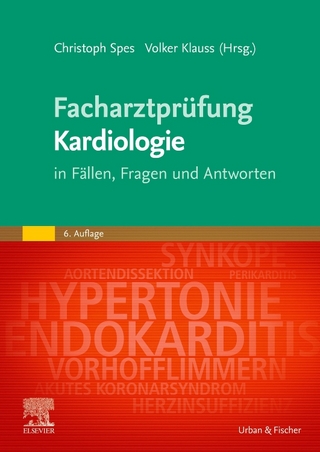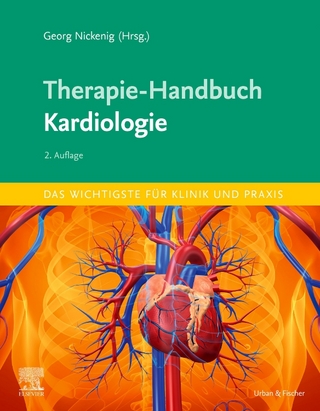
Heart Physiology and Pathophysiology
Academic Press Inc (Verlag)
978-0-12-656975-9 (ISBN)
- Keine Verlagsinformationen verfügbar
- Artikel merken
Heart Physiology and Pathophysiology, 4E, provides the foundation for the scientific understanding of heart function and dysfunction, and bridges the gap between basic cardiovascular science and clinical cardiology. This comprehensive text covers all the important aspects of the heart and vascular system. The most important and relevant disorders are presented, with emphasis on the mechanisms involved.
The first three editions of this book developed a reputation as the leading reference in cardiovascular science for researchers and academic cardiologists. This recent edition has been updated, expanded, and includes a number of new contributors. It has also been remodeled to expand its usage as a text reference for cardiology residents, practicing cardiologists, and graduate students.
Professor Sperelakis currently is Professor and Chairman Emeritus of Physiology and Biophysics at the College of Medicine at the University of Cincinnati. He is a cell physiologist specializing in cellular electrophysiology. Dr Sperelakis received a B.S. in Chemistry, M.S. in Physiology in 1955, and a Ph.D. in Physiology in 1957, all from the University of Illinois, Urbana. He was also trained in electronics, receiving a certificate from the U.S. Navy & Marine Corps Electronics School in Treasure Island, San Francisco. He served in the U.S. Marine Corps during the Korean War. Dr. Sperelakis is the author/co-author of over 550 scientific articles in journals and books. He has lectured at numerous universities worldwide and at international conferences/symposia. He has also trained many postdoctoral fellows and graduate students, and has been a visiting professor at several foreign universities. Professor Sperelakis has served on a number of journal editorial boards. He is a member of numerous professional societies and has served on the Council for several of them. He has served on the science program advisory committees for various international conferences and has organized several conferences. Dr. Sperelakis was an Established Investigator of the American Heart Association (AHA), Fellow at the Marine Biological Laboratory (Woods Hole), and elected Fellow of the American College of Cardiology (FACC). He received Awards for research excellence from Ohio AHA in 1995 and SW Ohio in 1996. His listings include Who's Who in the World, in America, in Science and Engineering, in Medicine and Healthcare, and in American Education.
Contributors
Foreword
Preface
Part I Pumping Action and Electrical Activity of the Heart
1. Sequence of Cardiac Activation and Ventricular Mechanics
2. Coronary Circulation and Hemodynamics
3. Neurohumoral Control of Cardiac Function
4. Control of Cardiac Output and its Alterations during Exercise and in Heart Failure
5. Ultrastructure of Cardiac Muscle and Blood Vessels
6. Excitability and Impulse Propagation
7. Electrocardiogram and Cardiac Excitation
8. Gap-Junction Channels and Healing-Over of Injury
Part II Cellular Electrophysiology of Heart and Vascular Smooth Muscle
9. Electrogenesis of the Resting Potential
10. Cardiac Action Potentials
11. Electrophysiology of Vascular Smooth Muscle
12. Sodium Channels
13. Voltage-Dependent Calcium Channels
14. Voltage-Dependent K+ Channels
15. Inwardly-Rectifying K+ Channels in the Heart
16. Voltage and Calcium-Activated K+ Channels of Coronary Smooth Muscle
17. Ion Channels in Vascular Smooth Muscle
18. Cardiac Pacemaker Currents
19. Chloride Channels in Heart
20. Regulation of Cardiac Ion Channels by Phosphorylation, Ca2+, Cytoskeleton, and Stretch
PART III PUMPS AND EXCHANGERS
21. Cardiac Na+/K+ Pump
22. Cardiac Na+–Ca2+ Exchanger: Pathophysiology and Pharmacology
23. Na+/H+ Exchanger and pH Regulation
24. Transport in Nucleus
25. Sarcoplasmic Reticulum Ca2+ Transport
26. Calcium Release from Cardiac Sarcoplasmic Reticulum
Part IV Vascular Endothelium
27. Function of Vascular Endothelium
28. Ion Channels in Vascular Endothelium
Part V Excitation–Contraction Coupling and Pharmacomechanical Coupling
29. Electromechanical and Pharmacomechanical Coupling in Vascular Smooth Muscle Cells
30. Mechanisms Regulating Cardiac Myofilament Response to Calcium
31. Vascular Smooth Muscle Contraction
Part VI Metabolism and Energetics
32. Myocardial Energy Metabolism
33. Metabolism and Energetics of Vascular Smooth Muscle
Part VII Signaling Systems
34. Adrenergic Receptors in the Cardiovascular System
35. Cardiac Action of Angiotensin II
36. ATP and Adenosine Signal Transductions
37. Kinase Signaling in the Cardiovascular System
38. Calcium Signaling
39. Diadenosine Polyphosphate Signaling in the Heart
Part VIII Developmental Changes and Aging
40. Cardiac Development and Regulation of Cardiac Transcription
41. Developmental Changes of Ion Channels
42. Aging of the Cardiovascular System
43. Changes in Autonomic Responsiveness during Development
Part IX Mechanism of Action of Cardioactive Drugs
44. Inotropic Mechanism in Cardiac Muscle
45. Mechanisms of Action of Calcium Antagonists
46. Cyclic Nucleotides and Protein Phosphorylation in Vascular Smooth Muscle Relaxation
47. K+ Channel Openers
48. Mode of Action of Antiarrhythmic Drugs
Part X Pathophysiology
49. Cellular Mechanisms of Cardioprotection
50. Ischemic Preconditioning: Description, Mechanism, and Significance
51. Cardioplegia and Surgical Ischemia
52. Apoptosis
53. Calcium Overload in Ischemia/Reperfusion Injury
54. Coronary Atherosclerosis and Restenosis
55. Diabetic Vascular Disease
56. Angiogenesis and Coronary Collateral Circulation
57. Molecular Pathophysiology of Cardiomyopathies
58. Signal Transduction of Cardiac Myocyte Hypertrophy
59. Electrophysiological Changes in Hypertrophy
60. Molecular Basis of Inherited Long QT Syndromes and Cardiac Arrhythmias
61. Molecular Mechanisms of Atrial Fibrillation
62. Lipids Released during Ischemia and Arrhythmogenesis
63. Ion Channels in the Heart
64. Cardiac Arrhythmias: Reentry and Triggered Activity
65. Myocardial Reperfusion Injury—Role of Free Radicals and Mediators of Inflammation
66. Cardiac Toxicology
67. Regulation of Gene Expression by Hypoxia
68. Gene Transfer in Cardiovascular Therapy
Index
| Erscheint lt. Verlag | 9.10.2000 |
|---|---|
| Mitarbeit |
Chef-Herausgeber: Yoshihisa Kurachi |
| Verlagsort | San Diego |
| Sprache | englisch |
| Maße | 216 x 279 mm |
| Gewicht | 3240 g |
| Themenwelt | Medizinische Fachgebiete ► Innere Medizin ► Kardiologie / Angiologie |
| Studium ► 1. Studienabschnitt (Vorklinik) ► Physiologie | |
| Studium ► 2. Studienabschnitt (Klinik) ► Pathologie | |
| ISBN-10 | 0-12-656975-4 / 0126569754 |
| ISBN-13 | 978-0-12-656975-9 / 9780126569759 |
| Zustand | Neuware |
| Haben Sie eine Frage zum Produkt? |
aus dem Bereich


